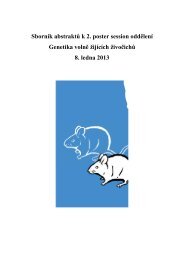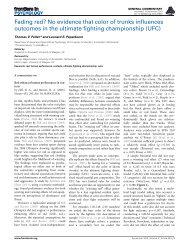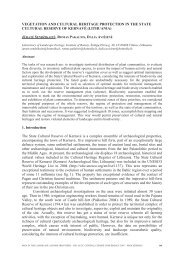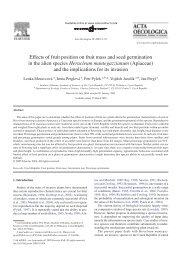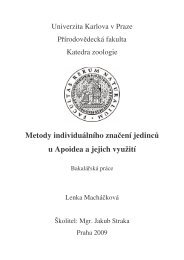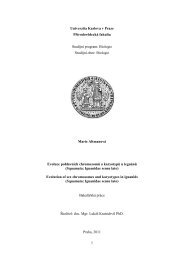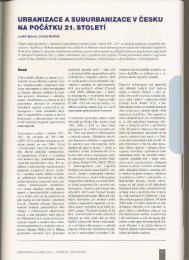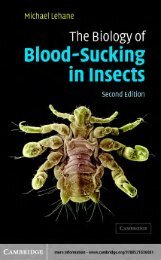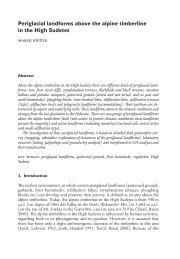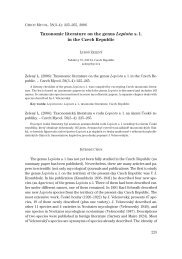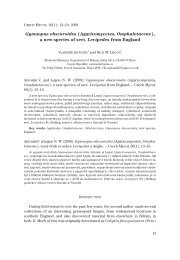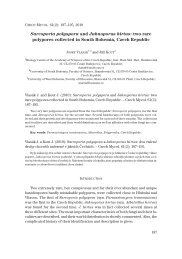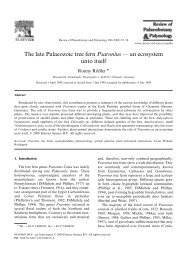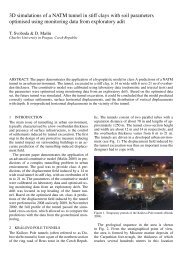The wood-rotting bluing Psilocybe species in Central Europe – an ...
The wood-rotting bluing Psilocybe species in Central Europe – an ...
The wood-rotting bluing Psilocybe species in Central Europe – an ...
You also want an ePaper? Increase the reach of your titles
YUMPU automatically turns print PDFs into web optimized ePapers that Google loves.
green or green when bruised or spont<strong>an</strong>eously, especially on dry<strong>in</strong>g. Smell radishlike,<br />
taste bitter-radish <strong>an</strong>d somewhat astr<strong>in</strong>gent. Spores <strong>in</strong> P. arc<strong>an</strong>a are of the<br />
same size as <strong>in</strong> P. serbica, (9.8<strong>–</strong>)10.5<strong>–</strong>12.5(<strong>–</strong>13.5) × (6.2<strong>–</strong>)6.5<strong>–</strong>7.1(<strong>–</strong>7.4) μm [Q =<br />
1.5<strong>–</strong>1.7<strong>–</strong>1.85]. Basidia 4-spored, with relatively short sterigmata (3.5<strong>–</strong>5 μm).<br />
P. serbica is a closely related <strong>species</strong>. However, it c<strong>an</strong> be dist<strong>in</strong>guished by frequent<br />
pleurocystidia <strong>an</strong>d by cheilocystidia with <strong>an</strong> often dist<strong>in</strong>ctly elongated neck<br />
(Fig. 3e) <strong>–</strong> see also Moser <strong>an</strong>d Horak (1968; figs. 1d <strong>an</strong>d 2a) <strong>an</strong>d Guzmán <strong>an</strong>d Bas<br />
(1977; fig. 7). Moreover, <strong>an</strong> obtusely umbonated pileus <strong>an</strong>d stipe dist<strong>in</strong>ctly attenuated<br />
downwards have not been reported for P. serbica.<br />
D i s t r i b u t i o n . Rather common <strong>in</strong> certa<strong>in</strong> areas of the Czech Republic (circa<br />
60 localities confirmed by the author), mostly <strong>in</strong> broadleaved forests (Quercus,<br />
Frax<strong>in</strong>us, Acer), but also under conifers (e.g., P<strong>in</strong>us). Several collections have<br />
been studied from Austria, Hungary, Norway <strong>an</strong>d Slovakia.<br />
P h e n o l o g y. September<strong>–</strong>November, fructification maximum <strong>in</strong> October.<br />
Selected illustrations. Anonymus (2003, p. 61), Assisi et al. (2008, p.<br />
300), Babos (1997, p. 11), Borovička (2005, figs. 11 <strong>an</strong>d 12), Borovička <strong>an</strong>d<br />
Hlaváček (2001a, 3 colour plates, front cover photo), Borovička <strong>an</strong>d Hlaváček<br />
(2001b, 1 colour plate; as “P. ore<strong>an</strong>a”), ? Hagara et al. (1999; as P. cy<strong>an</strong>escens),<br />
Hlaváček (1996, fig. 1; as P. cy<strong>an</strong>escens), Moser <strong>an</strong>d Jülich (1996, pl.: III <strong>Psilocybe</strong><br />
10; as P. cy<strong>an</strong>escens), Papoušek (2004, fig. 683).<br />
C o l l e c t i o n s e x a m i n e d . BRA (17 Sept. 1979 leg. J. Kuth<strong>an</strong>), BRNM 299093, BRNM 305602,<br />
BRNM 305899, BRNM 331852, BRNM 331878, BRNM 331900, BRNM 331908, BRNM 331912, BRNM<br />
457798, BRNM 576733, BRNM 642448, BRNM 648564, BRNM 648608, BRNM 648614, CB 6880, HR<br />
26638, HR 28926, HR 45436, HR 45470, HR 47855, L (9 Oct. 2006 leg. J. Borovička), O 177904, PRM<br />
813470, PRM 857426, PRM 891564, PRM 891566, PRM 895093 (holotype), PRM 896507, PRM 896508,<br />
PRM 896509, PRM 896510, PRM 901040, PRM 901171, PRM 901172, PRM 901642, PRM 901643, PRM<br />
901644, PRM 901646, PRM 901647, PRM 905466, PRM 905467, PRM 905476, PRM 905480, PRM 905482,<br />
PRM 905513, PRM 915262, WU 7985, <strong>an</strong>d ZT (Myc) 301.<br />
<strong>Psilocybe</strong> moravica var. sternberki<strong>an</strong>a Borovička, Czech Mycol. 58(1<strong>–</strong>2): 76<br />
(2006)<br />
I have seen only two fresh collections (holotype <strong>an</strong>d paratype) whose<br />
macrocharacters were similar to P. moravica var. moravica.<br />
D i s t r i b u t i o n . Known from just two neighbour<strong>in</strong>g sites <strong>in</strong> the Czech Republic<br />
(Moravia) <strong>an</strong>d one site <strong>in</strong> Germ<strong>an</strong>y (Bavaria).<br />
P h e n o l o g y. Probably similar to P. moravica var. moravica; holotype <strong>an</strong>d<br />
paratype collections were found on 1 November <strong>an</strong>d 26 October, respectively.<br />
Selected illustrations.Borovička (2006, fig. 2).<br />
184<br />
CZECH MYCOL. 60(2): 173<strong>–</strong>192, 2008<br />
C o l l e c t i o n s e x a m i n e d . PRM 901650 (holotype), PRM 901651 (paratype), <strong>an</strong>d PRM 905446.



